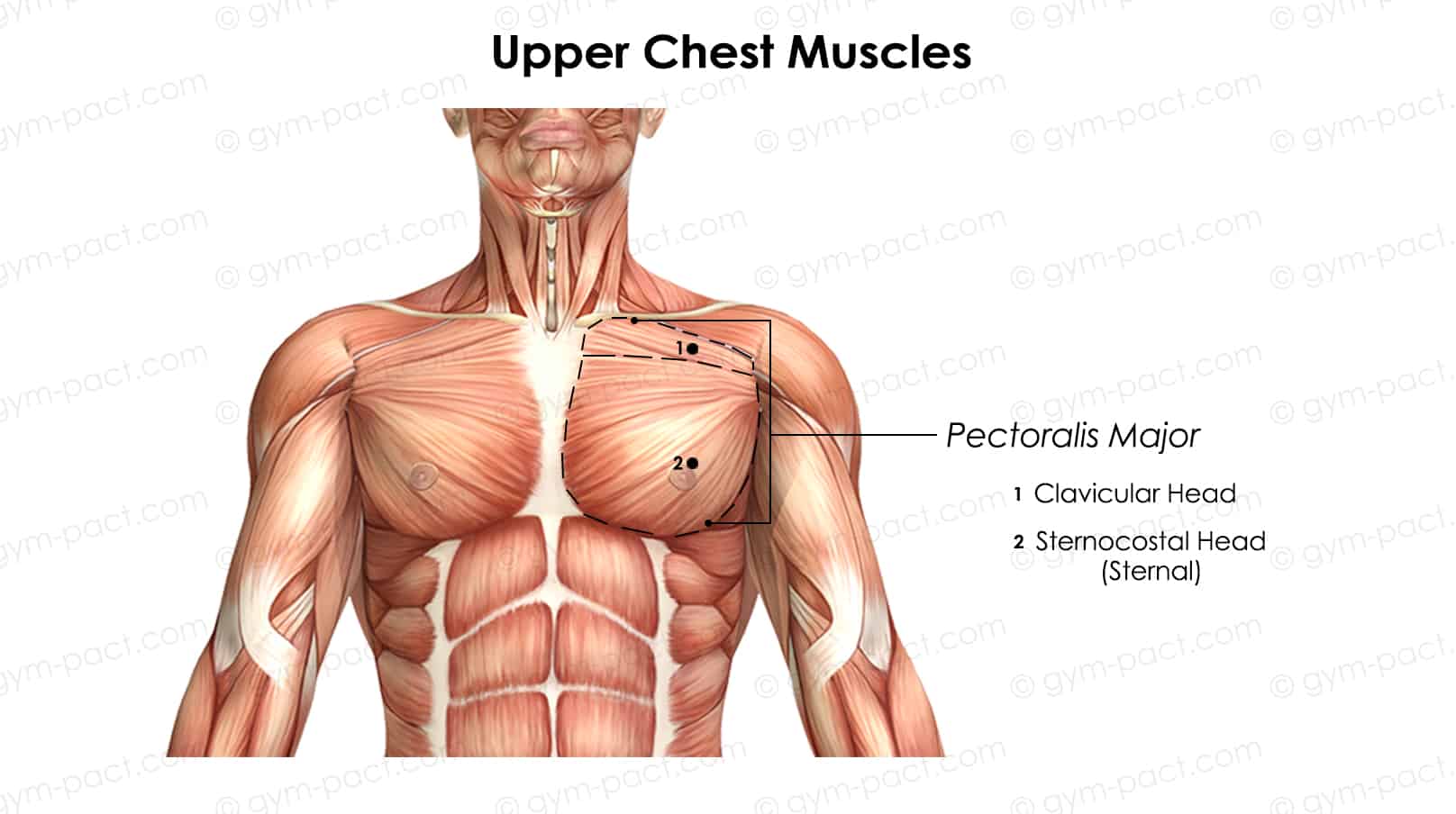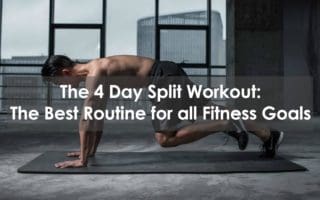Why Focus on the Upper Chest?
Outside of the abdominals and biceps, the chest muscles are one of the best to work to get the in-shape look. The main chest muscle is called the pectoralis major. The pectoralis major is broken down into two sections, the clavicular head (upper chest) and the sternal (mid to lower chest). The clavicular head is the one that I will focus on in this article because it gets overlooked when planning workout sessions.

The clavicular head is located on the clavicle (collarbone) and extends across the upper chest to the humerus (arm bone). This part of the chest muscle is primarily responsible for:
- Shoulder Abduction – Moves the arm at a lateral motion away from the body. Ex. exercise – Shoulder Fly
- Shoulder Adduction – Moves the arms down to the sides toward the body. Ex. exercise – Pull Ups
- Shoulder Flexion – Moves the arm up and forward away from the body. Ex. exercise – Front Raises
- Transverse Flexion – Moves the arms towards the body. Ex. exercise – Chest Fly
Working the upper chest will not only help achieve a greek god body, but it will also help you improve on other lifts. Increasing the strength and definition of the upper chest will lead to better performance with the bench press, military press, power cleans, and snatch lifts.
Best Upper Chest Workouts to Do at Home
Whether you have weights or not, you will be able to get defined pecs from the comfort of your home. Below we a list of 6 upper chest exercises. Some of the upper chest exercises below are for bodyweight and the others are for barbells and dumbbells.
1. Decline Pushup
Muscles worked:
The primary muscle worked in this exercise is the clavicular head of the chest and the secondary muscles are the lower portion of the chest muscle (sternal), front of the shoulder (anterior deltoid), and back of the arms (triceps).
Equipment set-up/used:
The decline pushup can be done almost anywhere with a suitably angled surface area.
How to do it:
All you will need to perform this lift is an elevated surface between the knee and hip height.
- You will start by putting your hands down like you would for a push-up.
- After placing the hands down, lift your feet onto the elevated surface.
- Once you are in position, begin to lower and bend the elbows until the upper part of the chest touches the ground and come back up.
- For more difficulty, use the bosu or stability balls to take away balance and stability.
Starting off perform sets of 8 repetitions until you build up enough strength to perform more. From personal experience, this lift is difficult because the upper chest is the primary muscle in the lift and it can be uncomfortable to have blood rush to your head while performing the exercise.
Coach tip:
The key to the exercise is to keep the back from caving down. If the back caves in, the push-up form will begin to fall apart and you will lean more towards the lower chest or shoulders to take most of the resistance instead of the upper chest. To keep the back from caving in, focus on tightening the abs and glute muscles. This will straighten out the back.
2. Pike Push Up
The last bodyweight upper chest entry on the list today is the pike push-up workout. Very similar to the decline pushup, this lift can be uncomfortable due to the blood rushing to the head.
Muscles worked:
The pike push-up works the same muscle as the decline push-ups, the sternal chest muscle, the anterior deltoid, and the triceps. During this lift, you will feel more of a workout in the shoulders and triceps due to the position of the lift.
Equipment set-up/used:
To get into a pike push-up, you will set up just like you would for a normal pushup.
How to do it:
- From a normal pushup position, you will walk the feet forward to make your body into an inverted v.
- Once in the inverted v, you will bend the arms to lower until your head is about to touch the ground (don’t let it touch the ground).
- After this, push through the arms to the beginning inverted v position.
Start off with 5 to 8 reps to learn the movement. To continuing progressing with this exercise, lift one foot off the ground and perform 5 reps and then switch to the other leg and perform 5 legs.
Coach tip:
This exercise is not in a natural position and can be difficult to have a good form if you don’t have strong abs. This exercise focuses on keeping the abs tight so the low back doesn’t cave in. You want a flat back when performing this exercise.
I personally have tight hips and if you do too, this position can be painful to hold. If you fall into this category, I recommend doing glute bridge exercises to loosen up the hips before this exercise.
3. Incline Bench Press (Dumbbell/Barbell)
The dumbbell or barbell incline bench press is one of the most popular exercises for the chest muscles.
Muscles worked:
This lift is not going to work the lower chest like the other exercise listed before. The only muscles included on this lift are the upper chest, front shoulder, and back of the arms.
Equipment set-up/used:
This exercise can be performed with barbells or dumbbells. You will also need an adjustable bench to set the bench to a 45-degree angle.
I highly recommend only doing the incline dumbbell bench press for safety reasons (dumbbells are a lot easier to drop than a barbell). Unless you have an incline barbell bench press station, don’t do incline barbell bench press. Please make sure you have a spotter if you do barbell incline bench press for safety. It will also be very difficult to lift the barbell up into the correct starting position without an incline bench press rack.
How to do it:
- Before grabbing the weights for this lift, make sure the adjustable bench is set up at the correct angle.
- A 45-degree angle is usually the best bet on this exercise.
- Going higher than a 45-degree angle will start to include shoulders more and going lower than a 45-degree angle will focus more on the lower chest muscles.
- Once the bench is set up correctly, grab the weights. My suggestion for getting into the starting position is to clean the dumbbells up to the upper chest and then slowly sit on the bench. It can be difficult to lift the dumbbells up to shoulder/upper chest height while sitting down on the bench.
- After getting the dumbbells into position and sitting down, begin extending the arms up and away from the body.
- Once the arms are fully extended, slowly bring the dumbbells back down to the chest.
I recommend starting with 10 to 12 reps for the incline dumbbell press. If 12 reps are too easy add some more weight.
Coach tip:
The key to this exercise is to keep the back on the bench and the feet securely on the floor. When lifting heavier weights most of us have the tendency to push throw our low back off the bench to produce enough force to lift the weight. Doing this may take the feet off the floor, which will be counterproductive.
Keeping the feet on the floor helps push force from the ground up through the chest and arms. Taking the feet off the floor puts the force point on the hips and low back which can lead to low back pain.
4. Standing Low to High Chest Fly
Muscles worked:
The primary muscle worked during the workout is the clavicular muscle. The secondary muscles worked during this workout is the anterior deltoid and biceps.
Equipment set-up/used:
The standing low to high chest fly can be done with multiple types of equipment. Most prefer to do low to high cable flys over low to high dumbbell flys. It will be very difficult to do this exercise with dumbbells because cables move in a fixed motion, while the dumbbells move more freely.
If you don’t have cables, you can use dumbbells. I would recommend going lighter on the dumbbells because most tend to swing the weight up instead of lifting it up slowly.
How to do it:
- To set up for the low to high cable chest fly, adjust the cable crossover machine handles around hip height.
- Then grab both handles and set your feet at shoulder width for balance.
- To set the feet, place one foot in the front and one in the back.
- This position should be about the same starting position for a lunge. The key here is to have a strong base of balance.
- If you feel like you’re leaning, spread the feet out wider than shoulder-width, this will make a secure solid base to perform this workout.
- After setting up the feet, you will begin the lift.
- Starting from the hands at the hips, move at an upward diagonal motion until the cables touch directly across from the chest and then come back to the starting point at the hips.
I suggest starting with 8 to 12 reps on the low to high chest fly.
Coach tip:
It’s super important during this lift to keep the arms bent at the elbow. Keeping the arms straight will put more stress on the shoulder and it will be hard to lift heavier weight.
On this exercise, it is key to avoid leaning back when lifting the weight. To counteract this, tilt the torso forward to create enough balance but don’t lean too far forward.
5. Incline Chest Fly
One of the most difficult upper chest workouts to perform is the incline chest fly. It’s difficult because the incline position and the chest fly motion put all the stress on the upper pecs.
Muscles worked:
The primary muscle worked during the exercise is the clavicular head. The secondary muscles worked during this exercise is the anterior deltoid and biceps.
Equipment set-up/used:
You will need an adjustable bench that you will be able to set at 45 degrees. This workout can be done with two types of equipment, cable crossovers or dumbbells. I would suggest using dumbbells because it can be time-consuming to adjust weights on both sides and setting up the bench in the correct spot.
How to do it:
- The set up for this exercise will be similar to the incline chest press. Set the angle of the bench at 45-degree angles and grab your dumbbells.
- To get into the starting position for this lift, I recommend lifting the dumbbells up to the shoulders before sitting down. This is so you don’t have to curl the dumbbells up when sitting down on the bench.
- After sitting down, press the dumbbells directly out from the chest at a 45-degree angle.
- Begin to bend at the elbows and move the weights out to the side. This motion is similar to moving away from a hug.
- The stopping point for this exercise is when your hands get to the same level as the bench. Going farther than this can cause strain on the chest and shoulders, which may lead to a muscle injury.
- After getting the hands on the same level as the bench, start the hugging motion to bring the hands and weights back to the starting position.
Starting off I would not go heavy with this lift and start with 5 to 8 reps to get the form and motion down before increasing weight.
Coach tip:
The key to performing this workout correctly is to keep the arms, hands, and weights at the 45-degree plane. Moving out of this plane will put pressure on the shoulders and lower chest.
Again the form of this exercise is to make a hugging motion and then back out of the hug. Visualizing this exercise like a hug will make this exercise easier to perform.
6. Incline Pull Over
Incline pull over is the most difficult upper chest workout on this list. Pull overs on a flat bench are already difficult enough. This upper chest workout is difficult because you will be fighting gravity when you pull the weight over the bench.
Muscles worked:
With this exercise, it is key to remember to push through the movement or the back will be worked instead of the chest. The primary muscle worked is the clavicular head of the chest and the secondary muscles will be the back, shoulders, and triceps.
Equipment set-up/used:
You will need an adjustable bench that can move to 45 degrees to get into the correct position. This exercise can be done with a barbell, EZ barbell, or dumbbells. Most do this with dumbbells, but I recommend using an EZ barbell. I personally have had the dumbbell catch the back of the bench. It can happen with a bar but a bar is easier to control than a dumbbell.
How to do it:
- To set up this upper chest workout, set the bench at the 45-degree setting.
- Grab the bar or dumbbell and place it across the upper chest or collarbone.
- After sitting down, bring the weight directly out from the chest and slightly bend the elbows.
- To start the workout, slowly start moving the weight to behind the bench while keeping the elbows bent.
- Once you get to the end of the bench, slowly push the weight back over to the start position.
Start with 5 to 8 repetitions until you get the form down.
Coach tip:
I know this workout is called “pull over” but pulling the weight back over will work the back. To do this exercise correctly remember to press when coming back to the start point. When performing this workout be aware of how close the weight is to your head and avoid catching the weight onto the back of the bench.
Conclusion
These 6 upper chest exercises are guaranteed to get you the best-looking upper pecs. Remember to always focus on the form before increasing weight on these workouts. To get the most out of each upper chest workout, go in slow and control movements.
Frequently Asked Questions
Can you really target the upper chest?
Yes, in general, all muscle groups can be individually targeted as a primary muscle during workouts. When working out the upper chest muscles, the anterior deltoid, the sternal pec muscle, and the triceps will be worked as secondary muscles. In the workout list above, the upper chest is the primary muscle worked.
How do I build my upper chest?
Doing any upper chest exercise will be the best way to build your upper chest. Doing upper chest workouts is just one piece of the puzzle though. To continue to build the upper chest pecs, you will need to get enough protein content to repair and rebuild the pecs.
What is the best exercise for the upper chest?
This depends on what equipment you have to work with. If you don’t have the equipment, the pike push up is the best upper chest workout. With dumbbells, the best upper chest exercise is the dumbbell fly. The incline pull over is the best barbell exercise for the upper chest muscles.
If you have all the equipment, the best exercise for upper chest muscles is the incline chest fly. The fly motion puts more focus on the upper chest muscles compared to the other upper chest exercises on our list.



